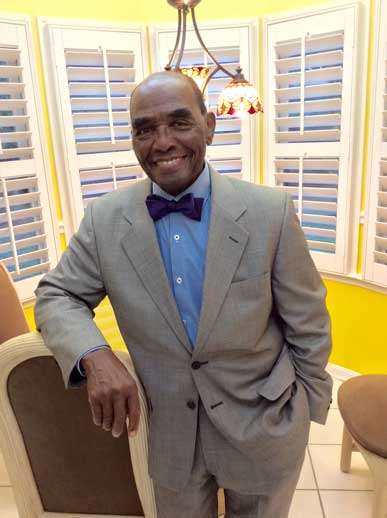The Story of the Month is now read by more persons and in more places than I imagined at the outset of distribution. The increase is due, in part, by your sharing these stories with your friends, a tendency that I authorize and encourage. I also invite your comments. One recent respondent asked that I identify myself with a picture, “So that we can see how you held up after so many adventures.” Well, this picture is “what’s left.”
The Shoe Box – Background
About three years ago as I talked out travelling with my grandmother, my graphic artist listened and sketched a picture of us boarding a train. It was so moving that I asked her to capture the same mood in something that I might use one day. What immediately caught my attention was how she framed my inquisitiveness as I inspected the cart of luggage, and how the conductor stood aside without assisting an old lady into the car. My artist is Barbara McArtor, and she lives in Beaufort, SC. She also created the cover for my first book, Half Way Home from Kinderlou, and the cover for the second, Forks in the Road.
The Shoe Box
Growing up in the 1930’s in Valdosta, Georgia, required the fast learning of two sets of rules and customs. Georgia, like all of the Southern states in that period, had separate laws and customs for Black folks and White folks. As a Black boy my parents taught that education was one way to overcome the harshness of segregation, but until you become wise enough to overcome, you should treat segregation as any problem that you can’t immediately solve: you must manage the problem to your advantage with whatever resources you have.
One community custom for “managing” a form of segregation was spawned in 1896. In that year the United States Supreme Court, in the case Plessy v. Ferguson, authorized Southern States to legally segregate public facilities for Black and White citizens, so long as they were “separate but equal.” The ruling specifically addressed separate railway coaches. Coaches for White passengers included dining cars. Black passengers had to pack their food. The most utile resource for that purpose was – a shoe box. There was a community understanding that whoever bought a new pair of shoes, the shoe box became community property for whoever needed it.
I was my grandmother’s travelling companion. A few days before our departure she carefully packed our clothes in her grip. When she told me our destination, it was my job to check the shed for a shoebox appropriate in size for the number of meals we needed. A shoe box for pumps or slippers would hold a sufficient meal for a trip to Atlanta, Macon, or Savannah. On our trip to New Orleans we needed two large boxes. Two neighbors, who knew our requirement, delivered the boxes they saved when they bought new brogans. There also was an unstated requirement to prepare enough food to share with those who might not have a meal. Furthermore, there was a ritual and formality to what was packed and how it was presented.
The day before departure Mama carefully washed a special set of small porcelain bowls and a collapsible metal cup. She placed them near the hand washed and ironed napkins and lace doilies. Every time Mama washed a special set of utensils, she stroked them gently, and her gaze seemed far away. One day she told me why. Not too many years earlier those utensils were used for her feeding, in the hands of her grandmother, a former slave.

Immediately after we boarded the train, and before the coal burning engine jerked forward and sent a shockwave and a billow of black smoke back to our car, Mama lowered her head and talked to God. “Master, take us there and bring us home.”
The time to eat was when someone opened their box and the whiff of the staple, fried chicken, permeated the car. Within minutes the air was filled with the aromas of ham, catfish, hush puppies, butterbeans, cornbread, okra, squash, rutabaga and turnip greens, blackberry and sweet potato pies. Foodstuffs that might melt or spill, like butter, gravy and syrup, were packed and carefully wrapped in a container with a lid – a Prince Albert tobacco can. But even before travelers began their meal, someone, as though guided by another custom, would walk the aisle and offer grace. And quite often as we ate, someone would start humming a Negro spiritual, and all passengers joined in. It was a sign of unity. It also was a way to manage a problem, while working on a solution.
The “separate but equal” doctrine was overturned by another United States Supreme Court in the case, Brown v. Board of Education, 1954.

